CONTENTS
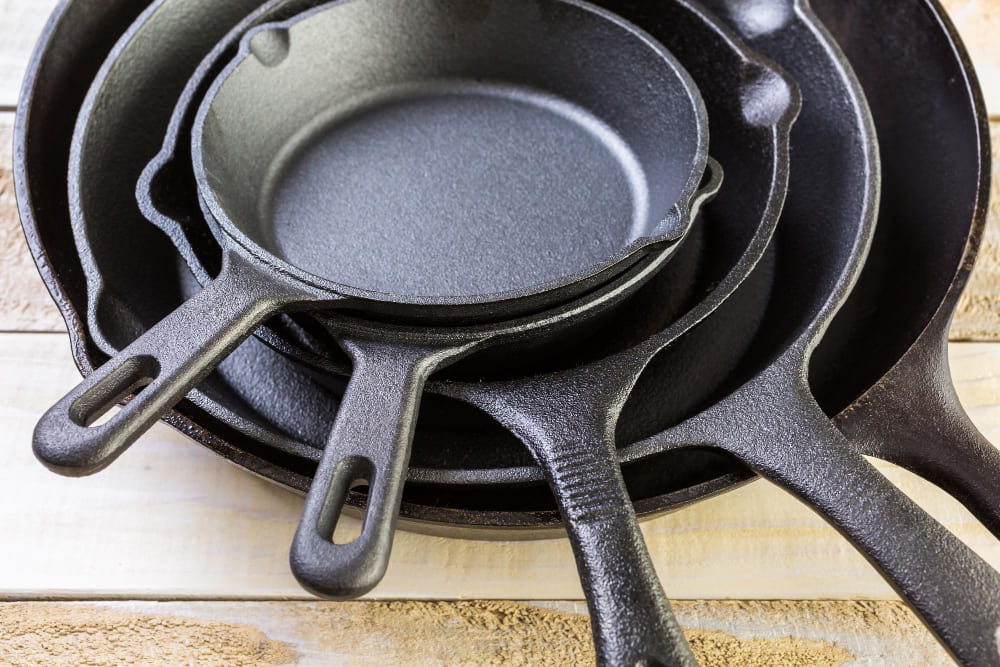
How to Clean Cast Iron Skillet: A Step-by-Step Guide
If you’re a fan of cast iron skillets, then you know they’re versatile and durable kitchen tools that can last for generations. But great power comes with great responsibility, and cast iron skillets require proper care and maintenance to keep them in top condition. One important aspect of maintaining your cast iron skillet is cleaning it properly after each use.
Ahead, we’ll walk you through everything you need to know about how to clean cast iron skillet effectively, so you can continue to enjoy delicious meals cooked to perfection on your favorite kitchen tool. Let’s get started!
Before You Clean a Cast-Iron Skillet
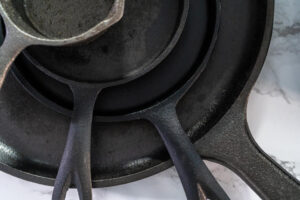
Before cleaning a cast-iron skillet, it’s important to note a few things to keep your skillet in its prime condition and eventually last longer.
Firstly, avoid using soap, steel wool, or the dishwasher so that the pan’s seasoning—the non-stick layer that prevents food from sticking and adds flavor to your dishes—won’t be stripped. Instead, opt for a scrubbing tool like a nylon brush or a rust eraser to remove any stubborn bits of food.
Additionally, ensure the skillet has cooled down completely before cleaning to avoid warping or cracking the metal.
Finally, thoroughly dry the skillet after cleaning to prevent any rust from forming.
Considering these factors, you can make sure that your cast-iron skillet stays in top condition and continues to serve you well for years to come.
How To Clean a Cast Iron Skillet
This simple guide will show you the best practices for cleaning your dirty, rusty cast iron skillet. So grab your skillet, and let’s get started!
Rinse and dry
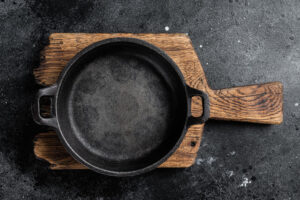
After usage, the first and most crucial step in cleaning your skillet is to rinse it off with hot water. This helps to remove any food residue or debris that may be stuck on the surface.
Then, use a gentle scrubber like a nylon brush to wipe the surfaces to avoid damaging the pan’s seasoning.
Once you’ve rinsed off the skillet, it’s important to dry it thoroughly to prevent any rust from forming. To wipe away moisture and allow the skillet to air dry completely, use a paper towel or a clean cloth.
Oil the interior
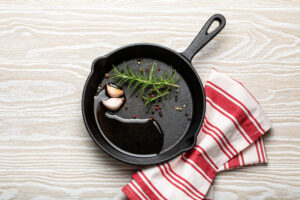
After drying the skillet completely, start taking a small amount of cooking oil and pour it into the cast iron skillet. Spread the oil evenly across the interior surface, including the sides and bottom, using a cloth or paper towel in a circular motion.
Once you’ve spread the oil, remove any excess oil from the skillet—a thin and even layer is all that’s needed. Wipe off any drips or pooling oil to avoid forming sticky spots during seasoning.
The oil glaze creates a protective layer that prevents food from sticking to the surface while you’re cooking. It also helps in building a natural non-stick seasoning over time. Additionally, the oil acts as a barrier against moisture, safeguarding the skillet from rust and corrosion.
Remove stuck-on bits
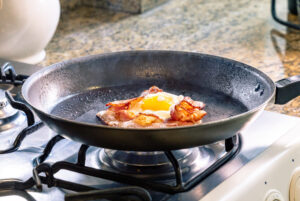
Remove any stuck-on bits from cooking leftovers to achieve a perfectly clean and well-seasoned cast iron skillet. Begin by heating the skillet on low heat to loosen the stuck-on bits. Then, sprinkle kosher salt and gently scrub with a wet sponge. Or you can also use folded potato skin, a natural bristles option.
Next, rinse with warm water while avoiding soap to preserve the seasoning. You can then proceed to glaze the interior with cooking oil.
Store in a dry place
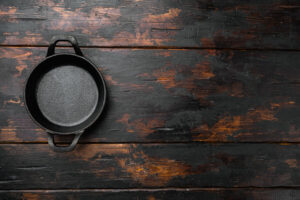
Store it in a dry, rustic cabinet to properly care for your beloved cast iron skillet. Avoid storing it with its cover and putting it around sinks, dishwashers, or cooktops. This protects it from moisture, preserving its flavors and ensuring its longevity.
If you happen to notice rust or graying skillet’s surface, it’s time to re-season it again.
How To Re-season Cast Iron
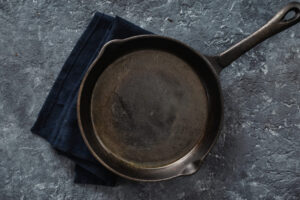
Re-seasoning cast iron is a simple but important process that can bring new life to your cookware. To start the process, you can follow the above methods of rinsing and oiling your pan. Then continue to heat the skillet in an oven.
Line the oven’s bottom rack with foil, preheat to 350-400°F, then bake the skillet upside down on the top rack for an hour. Cool it in the oven before storing it in a dry place.
To make your cast iron unique, consider adding your personal touch to the re-seasoning process. Maybe use a special type of oil, such as sesame, avocado, or vegetable oil, to add a unique flavor to your skillet. Or perhaps try a different baking time or temperature to experiment with how the seasoning sets on the cast iron.
Frequently Asked Questions
Am I allowed to soak my cast iron pan in water to loosen up any crusted food?
Yes, you can soak your cast iron pan in water to loosen crusted food. Start by cooling the pan, filling the sink with warm water, and submerging the pan. Let it soak for 15-30 minutes, then gently scrub with a non-abrasive brush or sponge. Finally, rinse and dry thoroughly.
Why are cast iron pans washed differently?
Cast iron pans are washed differently due to their seasoning and rust susceptibility. Harsh soaps and abrasive scrubbing can remove the seasoning.
If my pan is clean, why is food still sticking to it? And what is that black residue?
Food may still stick to a clean cast iron pan if the seasoning is insufficient or worn off. Meanwhile, the black residue is likely carbonized or polymerized oils from previous cooking, which contribute to the pan’s seasoning. Re-seasoning may be needed if the residue becomes excessive or flakes off.
Conclusion
In conclusion, cleaning and maintaining your cast iron skillet may seem daunting, but keeping your beloved kitchen tool in top shape is worth the effort. Following these simple steps, you can make sure that your skillet lasts for generations and continues to provide you with delicious meals.
Always clean your skillet immediately after use, avoid using soap or harsh detergents, dry the skillet thoroughly, and swipe a thin layer of oil to the surface to prevent rust from forming. This care and maintenance routine applies to other cookware like a non-stick pan as well. By following these steps, you can prolong the life and effectiveness of your non-stick pan, ensuring that it continues to perform well over time. And if you notice any signs of wear or a loss of non-stick performance, don’t be afraid to re-season your non-stick pan to restore its unique qualities.
By caring for your cookware, whether it’s cast iron or non-stick, you’ll continue a culinary tradition passed down for generations!

